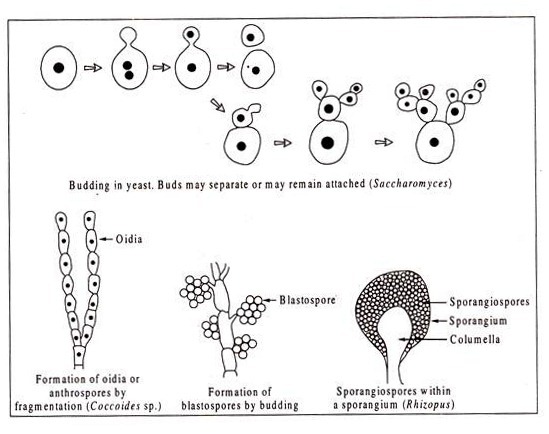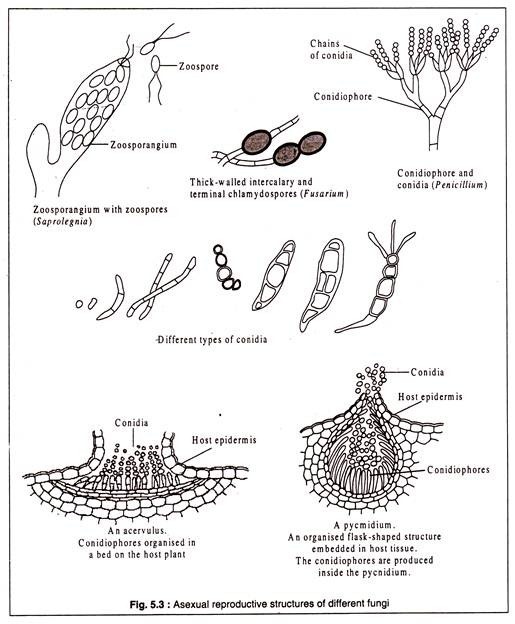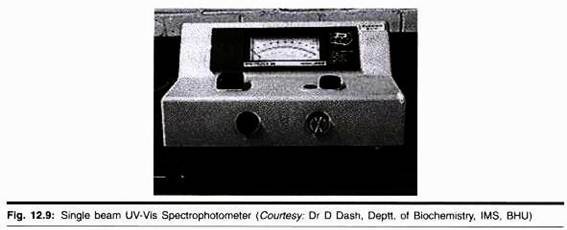In this article we will discuss about the asexual and sexual modes of reproduction in fungi with the help of diagrams.
(i) Asexual Reproduction:
Asexual reproduction of fungi may take place by a variety of ways. The unicellular forms may multiply by cell division, fission or budding. Yeasts multiply either by fission as observed in the species of Schizosaccharomyces, or by budding in members of Saccharomyces. Some ascospores and basidiospores may also multiply by budding.
The hyphal forms can multiply by fragmentation which may occur accidentally, or, in some fungi, it may occur through production of oidia or arthrospores. These thin-walled spores arise by cleavage of hyphae through splitting of the septa. In some fungi, the hyphal cells can produce thin-walled spores by budding. These spores are called blastospores.
In many fungi, asexual reproduction occurs through production of more specialized spores. Such spores may be produced in special sacs, known as sporangia and the spores are known as sporangiospores. Spores may also be motile and, in that case they are called zoospores.
Asexual spores in many fungi are produced from the tips of specialized hyphae in a highly characteristic manner depending on individual species. The specialized aerial hyphae are known as conidiophores and the spores as conidia. Sometimes, several conidiophores fuse with one another to form a columnar structure called a synnema or a coremium.
In some fungi, conidiophores, instead of being evenly spread, may be restricted in specialized areas as compact beds, known as acereuli. Depending on the shape of the conidiophore-bearing areas, they are called sporodochia, pycnidia etc. Many fungi also produce thick-walled spores, known as chlamydospores which may be formed singly or in chains and may be intercalary or terminal.
Different types of asexual reproductive units and associated structures are shown in Fig. 5.3:
(ii) Sexual Reproduction:
Sexual reproduction takes place by fusion of two nuclei originating from two individuals of opposite mating types, generally designated as male and female. Fusion of the nuclei is preceded by fusion of two protoplasts; the process is called plasmogamy.
Fusion of the nuclei is known as karyogamy. It leads to production of a diploid cell, called zygote. Eventually, meiosis takes place to restore the hyploid cells. In the higher fungi, i.e. in ascomycetes and basidiomycetes, karyogamy does not follow plasmogamy immediately.
Rather, the pair of nuclei divides synchronously to produce a dicaryophase. Ultimately, the two nuclei fuse to produce a diploid nucleus in a few cells before production of ascospores and basidiospores. The diploid nucleus undergoes meiosis immediately to produce haploid nuclei which pass into the ascospores and basidiospores.
Plasmogamy and karyogamy may occur in a number of different ways in different taxonomic groups of fungi as described below:
(a) Gametic union:
In lower fungi, such as chytrids, sexual reproduction takes place by fusion of male and female gametes. The male and female gametes may be morphologically similar (isogamy) or dissimilar (anisogamy). One or both gametes may be motile or non-motile (aplanogamy).
(b) Gametangial contact:
In many phycomycetes, such as Saprolegnia, sexual reproduction is effected by gametangial contact. A gametangium is the structure in which gametes are formed. The male and female gametangia come in contact and a pore is produced at the point of contact. The male gametes (nuclei) pass through the pore into the female gametangium where they fertilize the eggs or oospheres to produce diploid oospores.
(c) Gametangial copulation:
In the zygomycetes, such as Mucor, the male and female gametangia come in contact and the entire gametangia fuse with other. Thereby, their separate identity is lost and the fusion produces a zygospore. In the zygospore, the male and female nuclei pair with each other. Eventually, some of these pairs of nuclei fuse and the diploid nuclei undergo meiosis to restore haploidy.
(d) Spermatization:
In some basidiomycetes, such as the rust-fungus Puccinia, the male gametes are called spermatia which are produced in pycnidia (or spermogonia). The uninucleate non-motile spermatia are passively transferred by insects to the receptive female hyphae leading to plasmogamy. The male nucleus passes into the female receptive hypha and fuse with a female nucleus.
(e) Somatogamy:
In higher basidiomycetes, like mushrooms, specialized sex organs are totally absent. In these fungi, male and female nuclei are brought together by fusion of vegetative hyphae originating from mycelia of opposite mating types.
The different modes of plasmogamy are illustrated in Fig. 5.4:
Gametic union in Synchytrium endobioticum
Morphologically similar male and female gametes unite to produce a diploid zygote.
Gametangial contact in saprolignia sp. The male gametangium (antheridium) and female gametangium (oogonium) come in contact and the male nuclei pass into the oogonium through a pore to fertilize the oospheres (eggs) resulting in the formation of diploid oospores.
Gasmetangial copulation in mucor sp. The male and female gametangia fuse with each other to produce a zygospore. In the zygospore, numerous male and female nuclei pair with other (n+n).
The different modes of plasmogamy illustrated in Fig. 5.4 bring the nuclei of opposite sexuality together. Karyogamy leads to formation of a diploid nucleus which undergoes meiosis to produce the different types of sexual spores. The formation of sexual spores is variable in different taxonomic groups of fungi.
In the chytrids, such as Synchytrium endobioticum which causes wart disease of potato, the fusion of isogametes results in the formation of a diploid zoospore. The zoospores infect the host plant and form a resting sporangium. Eventually, the diploid nucleus divides meiotically to produce many haploid zoospores which, on liberation, infect new host plants (Fig. 5.5A).
In the lower phycomycetes, like oomycetes e.g. Saprolegnia, the fusion product is an oospore which, after a resting period, divides meiotically to produce haploid somatic mycelium (Fig. 5.5B).
In the higher phycomycetes, like Mucor, Rhizopus etc., the gametangial copulation leads to formation of a zygospore. It contains many pairs of nuclei. Some of these pairs of nuclei fuse to produce diploid nuclei, while others degenerate. The diploid nuclei undergo reduction division before the zygospore germinates into stalked sporangium containing numerous haploid sporangiospores. These spores are liberated by bursting open. The sporangiospores germinate to produce haploid mycelia of opposite sexuality (Fig. 5.5C).
In the ascomycetes, sexual union takes place between a female ascogonium and male antheridium. The male nuclei pass into the ascogonium, where the male and female nuclei form pairs, but do not fuse. The fertilized ascogonium increases in size and produces numerous outgrowths which develop into ascogenous hyphae. The ascogenous hyphae are septate and each cell contains a pair of nuclei— one male and one female.
The pairs of nuclei divide mitotically as the ascogenous hyphae continue to grow. Eventually, the tip of an ascogenous hypha bends to form a hook-like structure, called a crozier. The pair of nuclei present in the penultimate cell of the crozier fuse to form a diploid nucleus. This fusion nucleus (2n) divides meioticaly to produce haploid ascospores. The penultimate cell elongates and develops into an ascus containing ascospores (Fig. 5.5D).
These spores are liberated by different means and produce haploid mycelia. Thus, in ascomycetes, a single sexual act produces a large number of ascospores by postponing karyogamy and interposing a dikaryotic phase in between plasmogamy and karyogamy.
In the basidiomycetes, specially in the fruit-body forming types, like mushrooms, bracket fungi etc. (Holobasidiomycetes), typically plasmogamy occurs by fusion of somatic hyphae which results in the formation of a dikaryotic cell containing a pair of nuclei of opposite mating types. This dikaryotic cell develops into a dikaryotic mycelium, each cell containing a pair of nuclei (dikaryon).
A characteristic feature of many basidiomycetes is the presence of a clamp-connection in the dikaryotic mycelium. This structure possibly ensures that each cell of the hyphae gets one copy of the daughter nuclei of each dikaryon (Fig. 5.5E).
The dikaryotic mycelium grows indefinitely and may, under appropriate conditions, lead to formation of a fruit-body (basidiocarp). In some of the ultimate cells of the dikaryotic hyphae constituting the basidiocarp, the pairs of nuclei fuse to produce diploid nuclei which undergo meiotic division and produce haploid basidiospores (Fig. 5.5E). The basidiospores on liberation germinate to produce haploid mycelia of different mating types (tetra polar sexuality).
In other basidiomycetes, like rust-fungi, plasmogamy occurs by spermatization in the alternate host which is berberry. The fusion product gives rise to aeciospores (n+n) which infect wheat plants. In the wheat plant, teleutospores (n + n) are produced.
Karyogamy takes place when the teleutospores germinate. The diploid nuclei in the two-called teleutospores undergo meiosis to form haploid basidiospores. These spores infect berberry plants. In rust fungi, the basidia are septate (Fig. 5.5F).
Formation of sexual spores in different taxonomic groups of fungi is diagrammatically represented in Fig. 5.5A to E:








